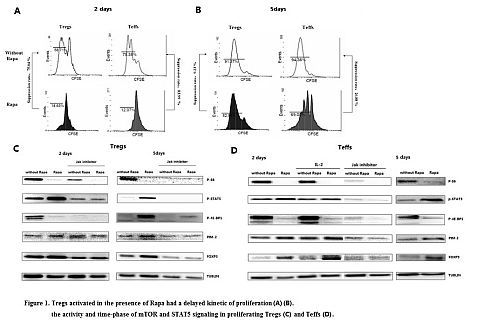Interplay between mTOR and STAT5 Signaling Modulates the Balance between Regulatory and Effective T Cells
West China Hospital, Sichuan University, chengdu, China
Meeting: 2013 American Transplant Congress
Abstract number: A722
Background: Allograft outcome, rejection or tolerance, often depends on the balance between regulatory T cells (Tregs) and effective T cells (Teffs). Rapamycin (Rapa) has been reported to selectively expand Tregs and promote de novo generation of foxp3+ Tregs, suggesting its potential role in inducing tolerance. But the mechanism by which Rapa regulating the Treg-Teff balance is unclear.
Method: Mouse CD4+CD25– Teffs and CD4+CD25+ Tregs are sorted by MACS. They were labeled with CFSE and cultured with anti-CD3/CD28 Ab±IL-2 for 6 days. Two rounds of stimulation of 3 days each were performed. Rapa or Jak Inhibitor was added to the culture when indicated. Cells were harvested after each round of stimulation. CFSE dilution, FOXP3 expression and the signaling via the mTOR and STAT5 pathways were determined.
Results: In the first round stimulation, both Tregs and Teffs proliferation was reduced by Rapa [Fig1.A], but after second round of stimulation, Rapa-exposed Tregs seems to have resumed its proliferative activity, however, the Teffs proliferation remained significantly reduced by Rapa [Fig1.B]. We next confirmed that mTOR is essential for Tregs activation, and found there is direct interaction between mTOR and STAT5 signaling: mTOR inhibition up-regulated the expression of phos-STAT5 and its down streaming targets including Pim-2 and Foxp3 in both proliferating Tregs [Fig1.C] and Teffs [Fig1.D], thus, Rapa raise Foxp3 expression. However, the phos-4E-BP1 expression pattern is different in Tregs and Teffs. 4E-BP1 is the common target of mTOR and STAT5 signaling, and plays a key role in cell proliferation. Rapa inhibits phos-4E-BP1 expression in both Tregs and Teffs at early stage of proliferation, but selectively raises its expression in Tregs after second round of stimulation[Fig1.C, D] .This may explains why Rapa inhibits Teffs growth, but delays Tregs proliferation.

Conclusion: These findings suggested that the interplay between mTOR and STAT5 Signaling modulate the Treg-Teff balance: mTOR inhibition weakens Teffs growth, but make Tregs shift to STAT5/pim-2 dependent proliferation, which is more beneficial to foxp3 maintain and induction.
To cite this abstract in AMA style:
Shan J, Feng L, Li Y. Interplay between mTOR and STAT5 Signaling Modulates the Balance between Regulatory and Effective T Cells [abstract]. Am J Transplant. 2013; 13 (suppl 5). https://atcmeetingabstracts.com/abstract/interplay-between-mtor-and-stat5-signaling-modulates-the-balance-between-regulatory-and-effective-t-cells/. Accessed December 15, 2025.« Back to 2013 American Transplant Congress
